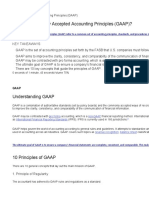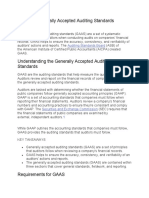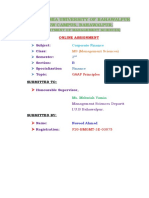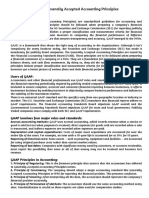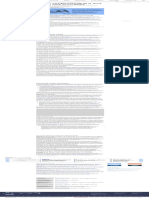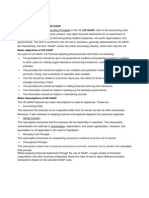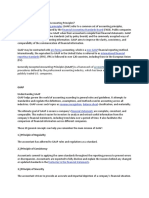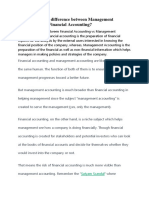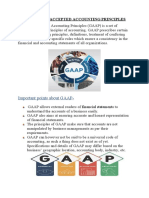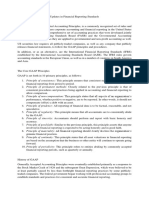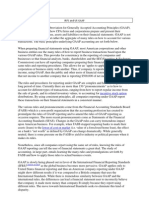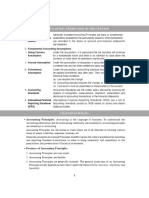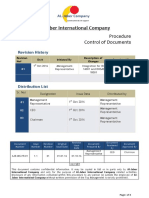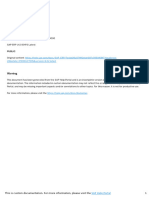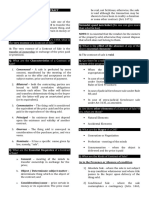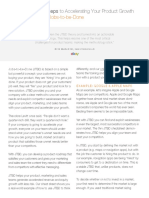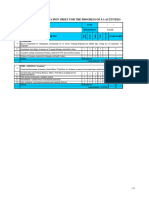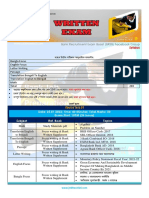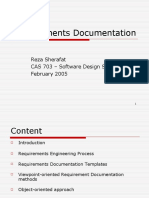Generally Accepted Accounting Principles (GAAP) and Generally Accepted
Auditing Standards (GAAS) are related to financial statement audits in the
following ways:
GAAP
A set of accounting rules that public companies must follow when reporting
their financial results. GAAP ensures that financial reporting is consistent,
accurate, and transparent across industries. The Financial Accounting
Standards Board (FASB) and the Governmental Accounting Standards Board
(GASB) issue and revise GAAP.
GAAS
A set of guidelines that auditors use to ensure that their audits are accurate,
consistent, and verifiable. The American Institute of Certified Public
Accountants (AICPA) issued GAAS auditing standards.
Auditor's role
Auditors review a company's financial records and accounting practices to
ensure they comply with GAAP. They also form an opinion on the validity of
the financial statement.
Audit report
An audit report must be included in the notes to the financial statements.
The auditor's written report must meet certain requirements.
:
�GAAP (Generally Accepted Accounting Principles)
• Purpose: GAAP provides the framework for preparing and presenting
financial statements.
• Focus: It sets out the accounting rules, standards, and principles that
companies must follow to ensure consistency, reliability, and comparability
of financial statements.
• Role in Audit:
• The financial statements being audited are prepared based on GAAP.
• The auditor evaluates whether the financial statements comply with GAAP.
• GAAP defines how transactions and events should be recognized,
measured, and disclosed.
GAAS (Generally Accepted Auditing Standards)
• Purpose: GAAS provides the guidelines for conducting an audit of financial
statements.
• Focus: It establishes the principles and procedures auditors must follow to
ensure audits are performed with due professional care, independence, and
competence.
• Role in Audit:
• GAAS guides how auditors plan, perform, and document the audit.
�• It ensures that auditors obtain sufficient, appropriate evidence to form an
opinion on whether the financial statements comply with GAAP.
• GAAS governs the auditor's responsibilities, risk assessment, and
communication with stakeholder
• GAAS guides now auditors pian, perform, and document the audit.
• It ensures that auditors obtain sufficient, appropriate evidence to form an
opinion on whether the financial statements comply with GAAP.
• GAAS governs the auditor's responsibilities, risk assessment, and
communication with stakeholders.
Relationship Between GAAP and GAAS
• GAAP is concerned with what financial information is reported, while GAAS
focuses on how the audit process is conducted to verify that information.
• Together, they ensure the integrity of financial reporting and provide
confidence to stakeholders in the reliability of the audited financial
statements.
Generally Accepted Accounting Principles (GAAP) and Generally Accepted
Auditing Standards (GAAS) have different roles in a financial statement audit:
@
GAAP
GAAP is a set of accounting rules and standards that public companies must
follow when reporting their financial results. GAAP's purpose is to ensure that
�financial reporting is consistent, accurate, and transparent across industries
and accounting periods.
GAAS
GAAS is a set of guidelines that auditors use to conduct financial statement
audits. GAAS helps to ensure that auditors' actions and reports are accurate,
consistent, and verifiable.
1. GAAP: Generally Accepted Accounting Principles (GAAP)
is a set of accounting standards and principles that
companies must follow when reporting their financial
results. GAAP aims to ensure that financial reporting is
consistent, accurate, and transparent across industries
and accounting periods. It provides a common language
for businesses to report their financial performance and
helps investors and other stakeholders make informed
decisions.
2. GAAS: Generally Accepted Auditing Standards (GAAS) is
a set of guidelines that auditors follow when conducting
financial statement audits. GAAS helps to ensure that
auditors’ actions and reports are accurate, consistent,
and verifiable. It provides a framework for auditors to
conduct and report on their work in a consistent and
rigorous manner.
3. Relationship: GAAP and GAAS work together to ensure
the reliability and transparency of financial information.
While GAAP focuses on the quality and consistency of
financial reporting, GAAS focuses on the quality and
consistency of the audit process itself. Both sets of
principles are essential for ensuring the credibility and
trustworthiness of financial statements and audit
reports.


